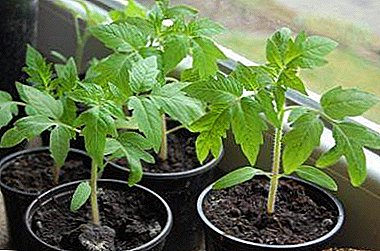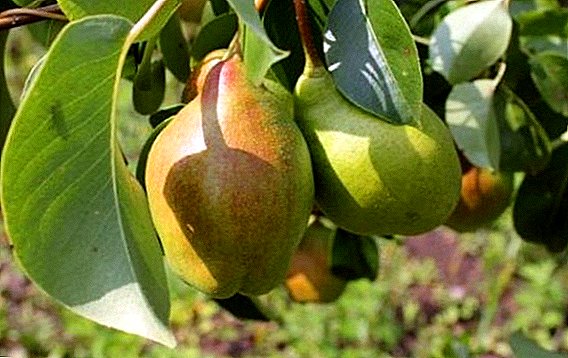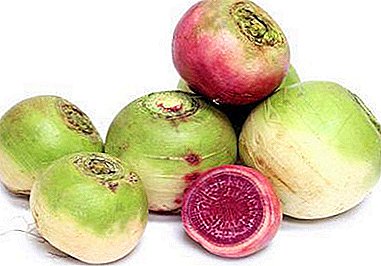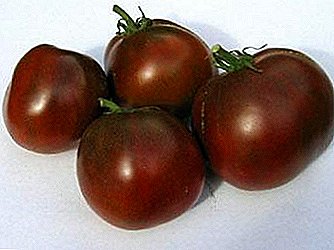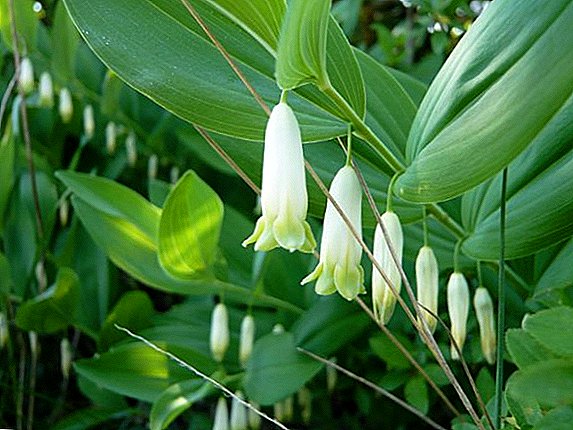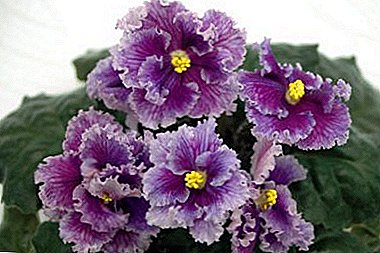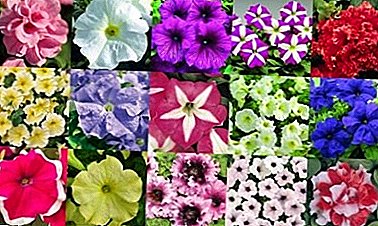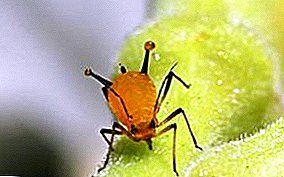
Aphid - a large family of sucking pests that are included in the order of hemiptera. Exists a huge number of aphid species, some of them settle and damage only certain cultures, others are omnivorous and can inhabit most plants.
You can meet various representatives of aphids in almost every region of the globe. Of course far not all types of aphids live in Europe. We will introduce the most common species.
general information

Aphid settles on plants and begins to suck the juices from them, forming necrotic patches.
One - the only individual will not cause serious harm, but the problem is that small pests multiply rapidly and form numerous colonies. In this regard, it is necessary to undertake various methods and methods of struggle.
The larger the aphid population, the more plants will die due to their activity. Some species even considered to be quarantine pestsFor example, grape phylloxera. How different types of aphids look, you can look at the photos posted in our article.
Other species form galls and other plant developmental pathologies.
Peach
Two subspecies are known - a large peach aphid and a greenhouse (aka tobacco and green) aphid.
Large
The founder has a rounded body brownish-gray color, up to 5 mm. The head is black with a short mustache. On the abdomen and chest are two tubercles. The male is the same color, but smaller. No wings.
 The winged virgin is distinguished by a smaller body - up to 4.5 mm, the color of the head and chest is black, the back and abdomen are gray and brown. The wingless virgin has a gray torso in the shape of a pear, covered, like the head with black spots. The legs are bright - yellow and orange.
The winged virgin is distinguished by a smaller body - up to 4.5 mm, the color of the head and chest is black, the back and abdomen are gray and brown. The wingless virgin has a gray torso in the shape of a pear, covered, like the head with black spots. The legs are bright - yellow and orange.
Eggs are orange colored first.which gradually darkens and turns brown. After a few days, it darkens, the eggs become black.
- Geographical distribution. Steppe areas and the Crimea.
- What plants are found on? Prefers fruit and nut trees - cherry plum, peach, almond, apricot, plum.
- Features of development and life cycle. Have a monoecious development cycle. Large huddles of eggs are sent for wintering, located on the inside of large branches and under the bark of the trunk. In April, the larvae appear and begin to feed actively, going through a developmental cycle to an adult within a month.From the founder, 50-80 larvae appear, from wingless virgins, on average, 30. The third and subsequent generations reproduce very intensively. Winged virgins appear in the middle of summer and begin to actively spread to other trees, forming all new colonies.
If you do not take action, by August the aphid population will completely cover all the trees in the garden, located on the inside of the leaves and branches. During the season 8-10 pest generations are formed. Males are born in the fall and fertilize females to form hibernating eggs.
- What harm does it do? Sucking the sap from the trees, the aphid cannot completely destroy the plant. However, its activity weakens the protective forces of the tree, which leads to the development of various viral diseases.
In addition, it gives way to soot fungi, which settle on the sweet aphid secretions. Externally, fungal invasion manifests itself in black wet spots.
Green or tobacco peach

Founder has an oval body, greenish - yellow, sometimes with a pink tint. In length reaches no more than 2.5 mm.
Wingless virgin of a smaller size, the body is colored pink, green-yellow or light green. The eyes are red, the antennae are light and short.. Average length - 1.5 - 2 mm.
Eggs elongated, elliptical. Color black with a metallic sheen.
- Geographical distribution. North America, Asia (especially Japan, China and India), Eastern and Western Europe, the Southern Urals.
- What plants are found on? Very illegible species that lives on peaches, cherry plums, plums, tobacco, cabbage, cucumbers, eggplants, potatoes, peppers, radishes, dill and parsley, lettuce and many other plants, including greenhouse crops and medicinal herbs.
- Features of development. Development is full cyclical or incomplete cyclical (when living in greenhouses). The larvae of the founders emerge from overwintered eggs in March - April. The air temperature must be at least 20 °. They begin to feed on the kidneys. Development to a mature individual from 18 to 28 days. The founder gives about 30-60 eggs of offspring. The maximum increase in population is observed in the middle of summer. Up to 12 generations can develop over a season. Winter eggs are carried out on the basis of the kidneys.
- What harm does it do? The most significant harmfulness is observed on young shoots and various vegetable crops, as well as tobacco. There is a twisting of leaves, wrinkling, the appearance of dried areas. It is very harmful to the flowers, which as a result dry and fall.
Potato large

Wingless virgin has an oval bodypointed at the back. It is colored red or green. The length is not more than 4 mm. Antennae and ponytail are long, in body color.
The winged virgin is small, up to 3.5 mm long. The little body is light green, the legs and antennae are brown.
- Geographical distribution. Almost everywhere. Initially appeared in North America.
- What plants are found on? As a polyphagous omnivorous, however, prefers potatoes, tomatoes, cabbage, beets, as well as greenhouse and indoor plants.
- Features of development. Incomplete development cycle. Reproduction only parthenogenetic.In spring, wingless individuals appear and settle on the inner side of leaf plates of forage crops. Wintering occurs on weeds and in the soil or in warm rooms.
During the season, there is a constant change of wingless and winged generations. All other forms are missing.
- What harm does it do? This type of aphid can carry around 50 varieties of viral diseases.
Apple Green
Egg - light greenish, gradually darkens until it becomes black. The founder has an oval body with a sharp rear tip. Painted green, head reddish or chestnut.
Wingless virgin is very similar to the founder. Smaller winged virgin, has a green belly. Paws, tail, chest and head are black.
The amphigonous female has no wings, the trunk is colored yellow with a brown or green tint. Ponytail and antennae black. The male differs from an amphigonous female only in smaller sizes.
- Geographical distribution. Eastern Europe, the Caucasus and Central Asia.
- What plants are found on? It prefers pome fruit trees - cotoneaster, apple, medlar, pear, quince, irgu, mountain ash, hawthorn.
- Features of development. During the season is replaced by several generations, differing morphologically. The larvae of the founding mothers emerge from the egg during the period of leaf bud development.
One individual gives up to 120 flightless virgins. The period of development is 9-13 days. In June, winged individuals appear, they begin to spread the population to different trees.
The number of generations depends on the habitat climate and ranges from 6 generations in cold regions to 17 in hot. Mating and laying of wintering eggs occurs in October.
- What harm does it do? Young saplings suffer the most. But mature trees also get quite a lot of damage. The leaves are curled, spots are formed on the fruit, branches and shoots are deformed.
Looks like a photo on a green apple aphid.
About the fight against aphids folk remedies read here.
Rose Green
All forms and stages of development are not very different from each other. Any individual has an ellipsoidal green body, brown long antennae, sword-like long tail.
- Geographical distribution. It lives almost everywhere.
- What plants are found on? In addition to roses and wild rose, aphid can live on strawberries, pears and apples.
- Features of development. It takes a full cycle. Hibernates on branches in the stage of eggs. Founders on average give about 80 eggs each. In greenhouses and greenhouses breeds all year.
- What harm does it do? The growth of bushes is inhibited, the leaves curl, the buds do not bloom, weakened plants do not tolerate the winter cold and the attack of viruses.
Leaf gallic

Wingless females have an oval body, painted in yellow or pale green. Antennae long, dark. Winged females are much smaller, they have a pair of transparent wings. The body is brown-brown.
- Geographical distribution. Everywhere.
- What plants are found on? White, red and black currants.
- Features of development. Full cycle.
- What harm does it do? Sucking the sap from the leaves, forms galls on them - swell burgundy or yellow. Young bushes are the most damaging, the population is capable of destroying the plant.
To protect plants, you can use chemical means to combat aphids.
Beet or Bean
Egg - black, ellipsoid. The founder and wingless virgin have an oval body, extended at the sides.
- Geographical distribution. Europe, North America, Central Asia and the South Caucasus.
- What plants are found on? Prefers beets, jasmine, euonymus, beans, poppy seeds, viburnum, spring vetch, sunflower and potatoes.
- Features of development. The alternation of generations throughout the growing season of forage plants, the last generation mates and lays wintering eggs.
- What harm does it do? The leaves shrivel and curl, the plant is inhibited in growth and may die. It carries various viral diseases.
Cucumber (melon)
The elongated body with a sharp rear tip is painted in different shades of green. Antennae and paws black.
Gourd aphid photo.
- Geographical distribution. Everywhere.
- What plants are found on? Gourds, cucumbers, beets, cotton, tobacco, peanuts, sesame, citrus, eucalyptus.
- Features of development. Parthenogenetic reproduction, development is incompletely cyclical. During the season, several generations of asexual virgins change. Fecundity - 40-50 individuals from the female.
- Harm caused. This species is one of the most harmful. It causes very great damage to plants due to its high fertility.
Cabbage
It has a wide oval pale green body, short dark antennae.
Cabbage aphid photo.
- Geographical distribution. Practically in all countries, in Russia it is absent in subtropical regions.
- What plants are found on? Dwells mainly on crucifers, especially loves radishes and cabbage.
- Development. In warm climates, development is incomplete, in the rest of the regions there is a full cycle. For the season appears from 6 to 30 generations.
- What harm does it do? Massively multiplying, clinging around the whole plant, which leads to death.
Grape phylloxera

The body is oval, the color is yellow or brown. Antennae and proboscis very short.
- Geographical distribution. Viticulture in Europe, North America, Africa and Asia.
- What plants are found on? It lives only on all types of grapes. Leaf form does not settle on pubescent species.
- Development. Root and leaf forms, go through a full cycle. One leaf female is capable of producing up to 500 eggs. For the season is replaced by up to 9 generations.
- What harm does it do? Phylloxera is a quarantine pest. On the roots appear galls, on the deformation of the leaves. The population is able to completely destroy the vineyard.
Carrot
The elongated oval torso is pale green in color, the antennae are short and light, as are the legs.
- Geographical distribution. Everywhere.
- What plants are found on? On carrots and other umbrella plants.
- Development. Full life cycle.
- What harm does it do? The leaves are curled, the nutrition of the roots deteriorates, so the quality and quantity of the crop suffers.
Poplar (poplar) white

Individuals have an oval torso of white or yellow color. Winged females are only white.
- Geographical distribution. Central Asia, Western Europe, Iran, Western Siberia.
- What plants are found on? On black, pyramid and other types of poplar.
- Development. Full cycle.
- Harmful. Drying of the buds, twisting of leaves, weakening of trees, especially young ones.
Hermes
The founder has a black shiny body. Subsequent generations are covered with white, fluffy hairs.
- Geographical distribution. Everywhere, where there are conifers.
- What plants are found on? Any conifers, especially spruce, pine, larch and cedar.
- Development. Incomplete. During the season 4-5 generations appear.
- Harmful. They violate the development and fruiting of trees, weakening protective abilities and reducing decorative effect.
Mealy (hairy)

The wingless female has a pinkish-creamy body, the shape is oval. Numerous setae are located on the sides. The whole body is covered with a snow-white bloom, resembling flour.
A winged female differs from a wingless one only by the presence of wings.
- Geographical location. Everywhere.
- What plants are found on? Prefers citrus, grapes, most indoor and greenhouse plants.
- Development. The female can lay up to 2 thousand eggs, from which the larvae will soon appear. They are mobile and crawl all over the surrounding plants, sucking the juice out of them. At home and in greenhouses, development and reproduction is continuous.
- Harmful. Deformation of branches and stems, drying and subsidence of buds and leaves, inhibition of development, weakening of the protective qualities of plants.
Root
The body can be painted in yellow, white or green, egg-shaped. Head, antennae and chest brown. The whole body is covered with a whitish yellow coating.like wax.
- Geographical location. Everywhere.
- What plants are found on? Almost everyone.
- Development. Wingless females hibernate in the soil. In the spring from them larvae are born. They subsequently hatch offspring. During the season is replaced by several generations and stages of development.
- Harmful. Sucking juices from adventitious side roots, the pest disrupt the normal flow of nutrients to the plant.
As a result, it weakens, cannot fully develop. If you do not take action - the fodder plant will die.
Home or room

Includes several subspecies that differ in coloring. There is a white aphid, a red aphid, there is also a green and black aphid.
- Geographical location. Everywhere.
- What plants are found on? Almost all indoor colors.
- Development. Full cycle. Parthenogenetic and periodically mating of amphiponous individuals. They do not go to wintering, they develop all year round.
- Harmful. Leaves, shoots and buds wither and dry, fall away. Plants stop growing, gradually die.
Conclusion
Aphids can be classified according to the preferences of food plants and habitat. Thus stand out garden aphid, flower, garden and plant.
Garden aphid lives on fruit trees and berry bushes, inflicting severe damage to garden plants. This order includes many insect species of various colors. The life cycle is often complete, with the change of different generations. The difference lies in the number of generations and the number of offspring.
Flower aphid prefers flowers and ornamental plants that live in flower beds, front gardens, flower beds.
Garden aphid settles on various garden plants - vegetables and herbs. The only exception is any type of onion and garlic.. There is no onion aphid in nature, as the volatile substances contained in plants scare away insects. This property is often used to combat aphids.applied spraying onion and garlic infusions. For information on how to deal with aphids, read the article "The best folk remedies to combat aphids part 1 and part 2".
Of course, It’s impossible to describe all aphids in one article.because there are so many of them. However, we tried to collect all the most common types.
Useful video!



